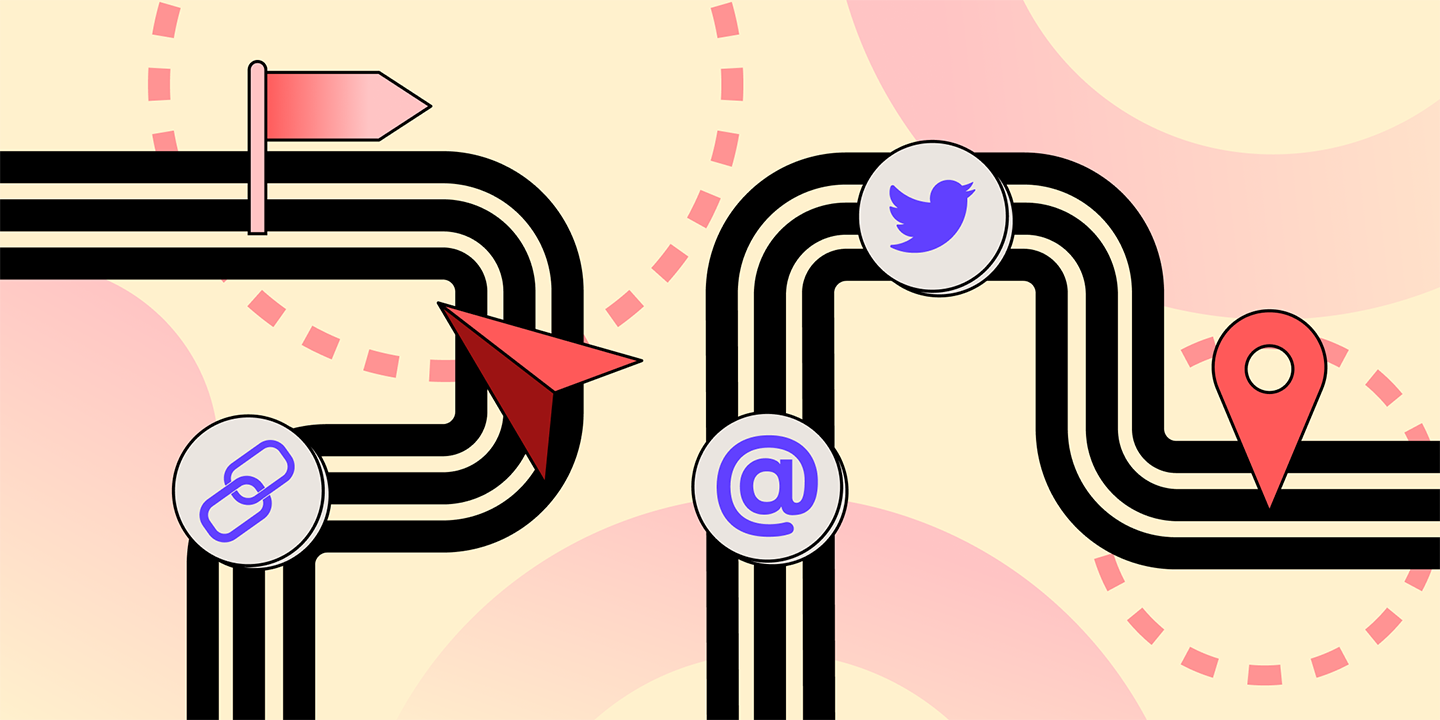A media mention occurs any time your brand name — or a keyword you're tracking — appears in the media. These mentions can show up in a variety of formats, including print newspapers, online news articles, magazines, blog posts, and even podcasts or social media.
Tracking media mentions is essential for understanding your brand’s visibility and reputation across all channels. Just like other core PR metrics, mentions need to be consistently and accurately monitored to measure the impact of your work.
This includes keeping tabs on both traditional media coverage and online conversations, where discussions about your brand may be occurring organically — and often without your involvement.
In this guide, we’ll explore what media mentions really mean, how to track them effectively, and how they fit into your daily PR workflow.
Try Prowly's media monitoring free for 7 days
Start tracking media mentions immediately for free (no credit card required) in Prowly.
- Comprehensive monitoring: Track the web, social media, print, and broadcast mentions
- Transparent pricing: Plans start at $258/month
- All-in-one platform: Get everything you need in one tool for PR, incl. media database, outreach, reporting, and more
What is a media mention?
A media mention on the best days in PR feels like kicking a field goal. It's a major score! On the most challenging days, negative press mentions can throw a wrench into your best-laid plans and pivot your PR campaign into a new direction.
The definition of “media mentions” can also depend on a PR campaign's goals. For a specific campaign or client, the definition may also include mentions on social media and in online discussion forums.
PR professionals track media mentions for the brands they represent and their competitors. They also track keywords related to the brand's industry to determine the most discussed topics at the moment.
Tracking media mentions is a frequent and regular task for PR. It is often done daily to keep track of what news is breaking online.
Why are media mentions important?
So why is so much time and energy invested in tracking media mentions?
Because media mentions increase brand awareness, a critical function of PR for a brand's sales funnel.
Here’s why they matter:
- Visibility
Every mention expands your reach. Whether it’s a feature in a niche blog or a shout-out on social media, mentions put your brand in front of new audiences — often organically. - Social proof
Mentions act as third-party validation. When media outlets, influencers, or communities talk about your brand, it builds trust and credibility in ways ads can’t. - SEO impact
Online media coverage often includes backlinks — helping you climb search engine rankings and drive long-term organic traffic. - Measurable PR results
Tracking mentions over time helps you connect PR efforts to tangible outcomes like reach, sentiment shifts, share of voice, and sales conversions — essential for reporting and budget justification. - Crisis monitoring
Mentions help you spot emerging issues early. Real-time alerts mean you can act fast before a small problem blooms into a brand crisis. - Stakeholder confidence
Regular media visibility boosts your reputation with investors, partners, and internal teams. It shows your brand has momentum.
In monthly PR reports, media mentions are also highlighted and assessed for individual value. They are typically what a PR's client or supervisor views as “results” at the end of a PR campaign.
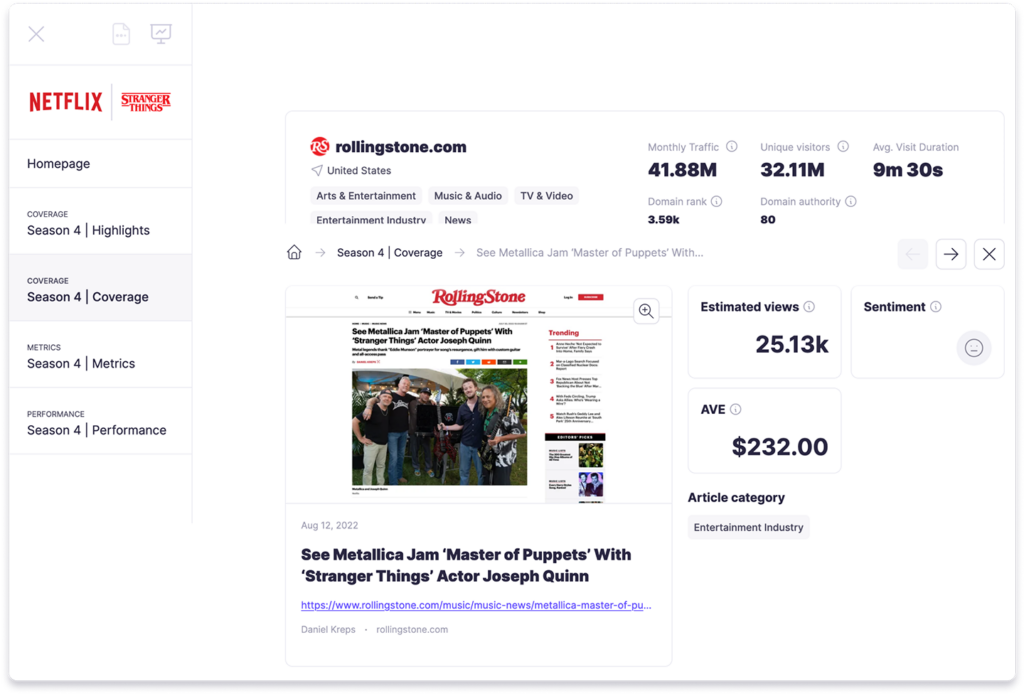
This is exactly why a PR professional wants to catch all media mentions and identify the particular value of each one.
How to track media mentions
Tracking media mentions is one of a PR professional's most important tasks. It's that one PR task that will never get skipped because it's so closely linked to measuring the value of your work.
PR professionals use one of three methods to track mentions:
- Media monitoring tools
- Google Alerts
- Manual searches
→ Media monitoring tools
Media monitoring tools and brand monitoring tools do all the heavy lifting for you, automatically tracking media mentions and sending you alerts based on your custom filters. They're reliable, provide data in a user-friendly manner, and can even generate your monthly PR reports.
Tracking media mentions using media monitoring tools help you:
- Track mentions across digital, print, broadcast, social, and podcasts
- Save hours by automating what would manually take days
- Analyze sentiment, reach, and trends and present it all on one dashboard
- Stay ahead of crises by catching negative press early
Some tools, like Prowly, let you monitor both digital and print & broadcast media. To ensure you don't miss anything important, make sure you're tracking mentions across all core media channels, including:
- Broadcast
- Online news and blogs
- Social media
- Discussions and communities
- Podcasts
Print media mentions
While less immediate, print mentions — such as those in newspapers and magazines — still carry prestige and long-term brand value. With print monitoring, you can get instant access to several global, national, regional, and local newspapers, trade publications, consumer magazines, and business journals.
Make sure your monitoring tool can track both and digital and print mentions.
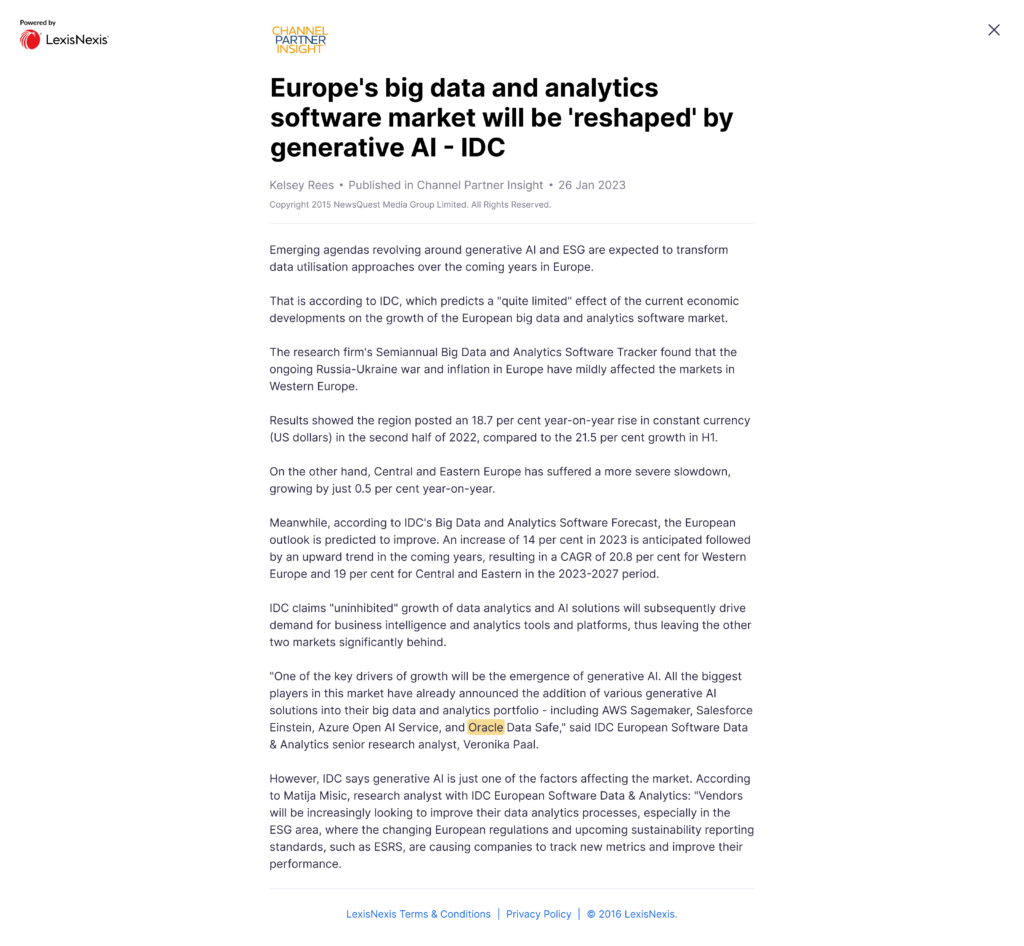
Broadcast mentions
TV and radio still shape public perception, especially in regional or traditional markets.
Broadcast mentions are harder to track manually — this is where media monitoring tools shine.
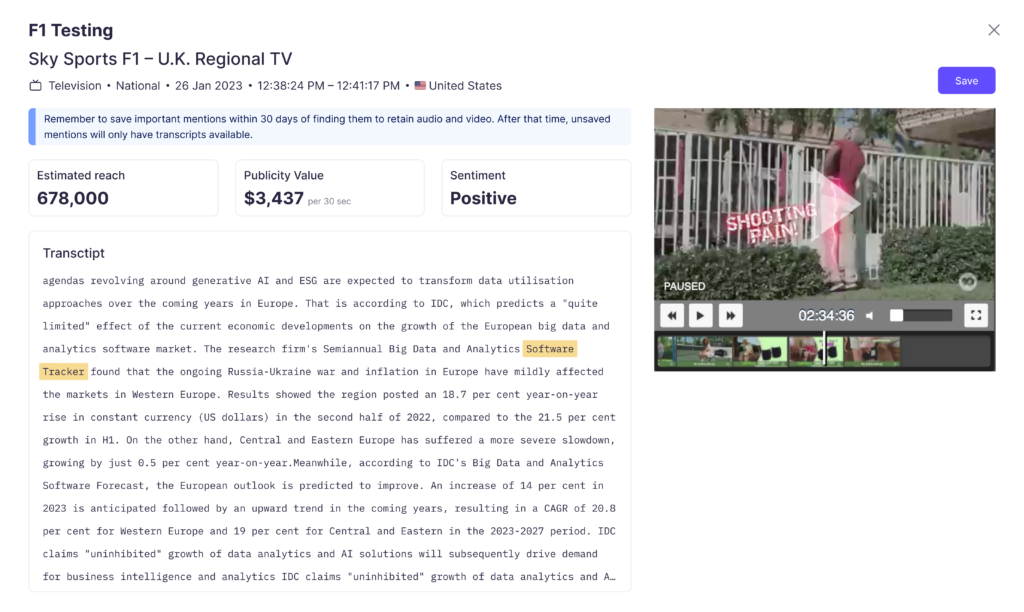
Try Prowly's broadcast monitoring free for 7 days
Start tracking your brand and keywords for free (no credit card required) in Prowly.
- Comprehensive monitoring: Track the web, social media, print, and broadcast mentions
- Transparent pricing: Plans start at $258/month
- All-in-one platform: Get everything you need in one tool for PR, incl. media database, outreach, reporting, and more
Online news & blog mentions
Still the go-to source for industry updates and breaking news. Mentions in online publications or influential blogs often signal credibility and authority.
Tip: Track branded keywords, executive names, and campaign mentions.
Social media
Mentions here spread fast — and wide. Social buzz can amplify a campaign or spiral into crisis.
Tip: Monitor platforms like X (Twitter), LinkedIn, Facebook, and Instagram for brand mentions, hashtags, and sentiment.
Discussions & communities
Your brand might be discussed in forums like Reddit, Quora, or niche Slack groups — often with raw, honest feedback.
Tip: Use tools that pick up on mentions beyond the mainstream.
Podcasts
Podcasts are an increasingly influential space, especially in B2B and niche industries. Mentions here often come with more in-depth commentary.
Tip: Some advanced tools even transcribe and index podcast content.
For a more detailed guide on how to effectively conduct media monitoring, including setting up queries and analyzing your results, check out our article: How to Do Media Monitoring: Tips & Best Practices.
→ Google Alerts
The second method is using Google Alerts, which is often tempting because it’s a free service that’s simple to set up. However, we’ve already written about how limited its results can be.
Many mentions get missed, and the alerts aren’t always timely. Essentially, it’s not reliable enough to trust with this important task.
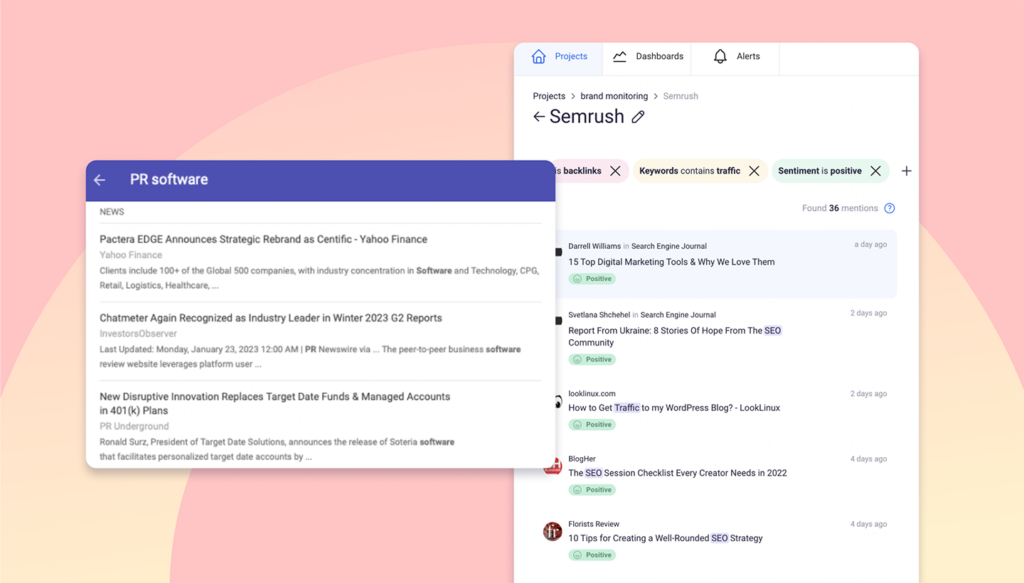
After trying both methods, most PR professionals decide to track brand mentions most easily, using media monitoring tools.
→ The manual search
This is when a PR professional searches for brand names and keywords in multiple search engines to find mentions. Yes, we’re talking about entering a list of keywords one by one into Google and looking through pages of results.
Since media mentions tracking is usually a daily task, you can quickly see how much time this can take away from a busy PR pro’s schedule! Even if this work is delegated to a junior team member, there is a substantial cost involved with the necessary labor hours.
How to never miss a media mention
With so much at stake, it’s no wonder PR professionals turn to automated PR software like Prowly to get solid media monitoring coverage and build impressive PR reports that “wow” their clients.
Here is what you need to do to stay informed:
1. Set up comprehensive monitoring
In Prowly's media monitoring, you can simply set:
- Brand names
- Spokesperson mentions
- Keywords
- Backlinks
- Specific authors
The tool scans online news sites, blogs, and discussion platforms like Reddit to dig up relevant media mentions — even picking up backlinks to your website and campaign URLs.
Not only can Prowly's media monitoring tool find international mentions, but it can also find mentions before Google has even indexed them, so you can see them earlier than a manual Google search would provide.
2. Set up filtering
Customize your monitoring to focus on what's most relevant:
- Source types: Choose between digital, print, broadcast, or social media sources.
- Geographical filters: Narrow down mentions by country or region.
- Language preferences: Monitor mentions in specific languages.
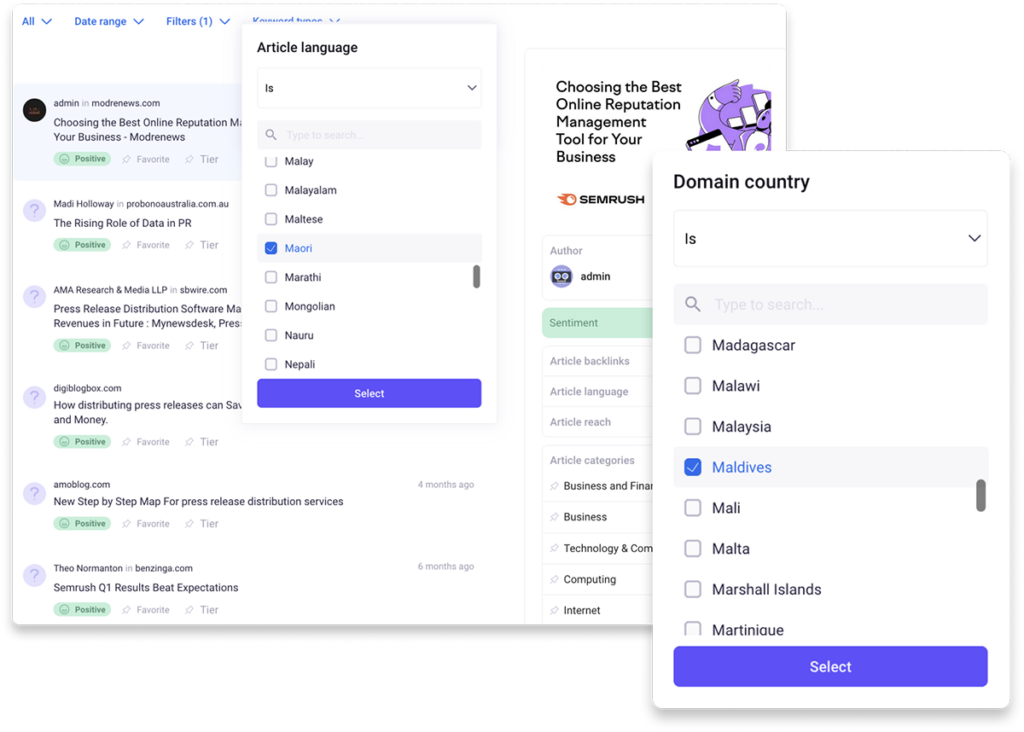
In the Prowly Media Monitoring, you can set up email alerts tailored to your preferences — so when you start your workday, your latest media mentions are already waiting in your inbox. No more manual scanning.
3. Add context & insight
Prowly doesn’t stop at finding mentions — it adds context with detailed metrics like:
- Sentiment
- Domain authority
- Estimated reach
Your results are presented in a clean, easy-to-navigate dashboard, letting you analyze, strategize, and act faster.
You can also track advanced metrics like Share of Voice and AVE alternatives, giving you a fuller picture of your PR impact.
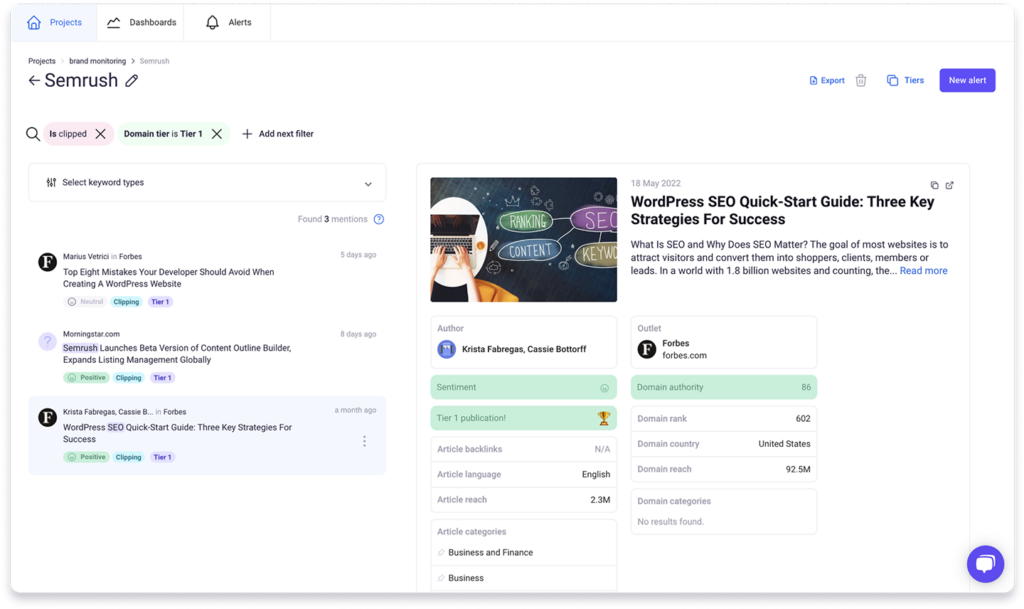
4. Create custom PR reports
PR automation software turns recurring tasks that feel like a chore into a valuable dashboard where campaign results can be analyzed and reported quickly.
With PR automation, you spend less time chasing mentions and more time responding strategically.
Plus, having faster access to results-driven data helps you pivot underperforming campaigns or double down on what’s working.
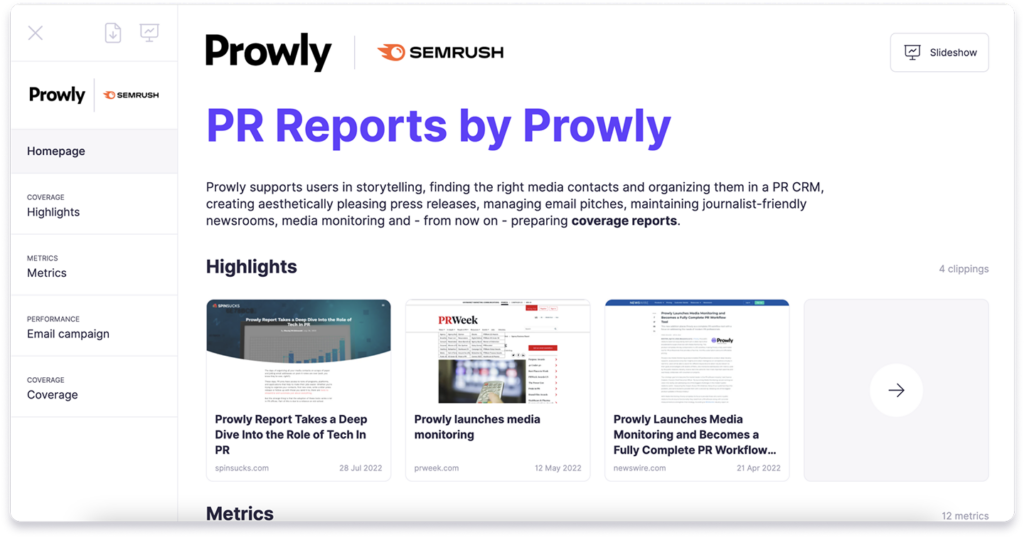
Getting started with media mention monitoring
PR pros approach media mention monitoring in three ways: manual research, Google Alerts, or media monitoring tools.
All can provide data to analyze and report, but only one approach provides real-time, thorough data with details like sentiment, reach, and media outlet importance.
If you’re ready to try a media monitoring tool (with added PR reporting!), we’re here to help you get started as soon as possible.
